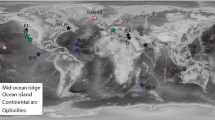Abstract
Using the Severnaya Dvina Basin as an example, it is shown that information on the distribution of natural U isotopes in aquifers can be applied for practical estimation of the duration of interaction between groundwater and host rocks (age of groundwater). The proposed calculation method includes preliminary determination of the generalized calculated parameter (probability of the transfer of 234U excess to water) based on geological benchmarks, hydrodynamic calculations, and paleohydrogeological reconstructions. It is assumed that this probability is constant for aquifers composed of homogeneous rocks with certain lithological composition and oxidizing conditions for U. The obtained correlations are valid for a model, where water entering the aquifer lacks U. If it contains such U, the “transport” time, which is equivalent to the timing of respective concentrations and isotopic ratios in the aquifer unit, is determined and estimates of the “water-rock” interaction in the aquifer unit are corrected.
Similar content being viewed by others

References
Andrews, J.N. and Kay, R.L.F., The evolution of enhanced 234U/238U activity ratios for dissolved uranium and groundwater dating, Short Pap. Fourth Int. Conf. “Geochron., Cosmochron., Isotope Geol.,” U.S. Geol. Surv. Openfile Rep., 1978, pp. 11–13.
Andrews, J.N., Giles, I.S., and Kay, R.L.F., et al., Radioelements, radiogenic helium and age relationships of groundwaters from the granites at Stripa, Sweden, Geochim. Cosmochim. Acta, 1982, vol. 46, no. 9, pp. 1533–1543.
Barr, G.E., Lambert, S.J., and Carter, J.A., Uranium isotope disequilibrium in groundwaters of southeastern New Mexico and implications regarding age-dating of water, in Proc. Int. Symp. Isotope Hydrology, STI/PUB/493, Vienna: I.A.E.A, 1979, vol. 2, pp. 645–660.
Bolikhovskaya, N.S. and Molod’kov, A.N., Scheme of periodization, correlation, and age of Pleistocene climatic events, in Fundamental problems of the Quaternary: Results of study and major lines of further studies. Materials of VI All-Russia Conf. on Study of the Quaternary Period, Novosibirsk: INGGSO RAN, IGM SO RAN, 2009, pp. 75–78.
Chalov, P.I., Mechanism of the formation of nonequilibrium relationships between natural radioactive isotopes in the U- and Th-bearing natural compounds, Atomn. Energ., 1969, vol. 27, no. 1, pp. 26–32.
Cherdyntsev, V.V., Isotopic composition of radioelements in natural bodies in relation to issues of geochronology, in Trudy tret’ei sessii Komissii po opredeleniyu absolyutnogo vozrasta geologicheskikh formatsii (Trans. 3rd Session Commission for Determination of the Absolute Age of Geological Formations), Moscow: AN SSSR, 1955, pp. 175–233.
Clark, I.D. and Fritz, P., Environmental Isotopes in Hydrogeology, Boca Raton, FL: CRC Press, 1997.
Ferronskii, V.I. and Polyakov, V.A., Izotopiya gidrosfery Zemli (Isotopy of the Earth’s hydrosphere), Moscow: Nauchn. Mir, 2009.
Fröhlich, K. and Gellermann, R., On the potential use of uranium isotopes for groundwater dating, Chem. Geol., 1987, vol. 65, no. 1, pp. 67–77.
Fröhlich, K., Ivanovich, M., Hendry, M.J., et al., Application of isotopic methods to dating of very old groundwaters: Milk River aquifer, Alberta, Canada, Appl. Geochem., 1991, vol. 6, no. 4, pp. 465–472.
Garrels, R. and Christ, C., Solutions, minerals, and equilibria, New York: Harper and Row, 1965.
Geyh, M., Amore, F.D., Darling, G., et al., Groundwater saturated and unsaturated zone, in Environmental isotopes in the hydrological cycle—principals and application, Mook, W.G., Ed., Vienna, 2001, vol. 4.
Kazemi, G.A., Lehr, J.H., and Perrochet, P., The age of groundwaters, Hoboken, N.J.: Wiley Interscience, 2006.
Kigoshi, K., Alpha-recoil 234Th: dissolution into water and the 234U/238U disequilibrium in nature, Science, 1971, vol. 173, pp. 47–48.
Kronfeld, J., Gradsztajn, E., Müller, H.W., et al., Excess 234U: an aging effect in confined waters, Earth Planet. Sci. Lett., 1975, vol. 27, no. 2, pp. 342–345.
Larsen, E., Lys., Demidov, I., et al., Age extent of the Scandinavian ice sheet in Northwest Russia, Boreas, 1999, vol. 28, no. 1, pp. 115–132.
Lisitsin, A.K., Hydrogeochemical model of the infiltrational ore-forming system, Geochem. Int., 1997, no. 3, pp. 271–280.
Malov, A.I., Podzemnye vody Yugo-Vostochnogo Belomor’ya: formirovanie, rol’ v geologicheskikh protsessakh (Groundwaters in the southeastern White Sea region: formation and role in geological processes), Yekaterinburg: UrO RAN, 2003.
Malov, A.I., The water-rock interaction in Vendian sandyclayey rocks of the Mezen syneclise, Lithol. Miner. Resour., 2004, no. 4, pp. 397–408.
Malov, A.I., Kiselev, G.P., and Rudik, G.P., Uranium in groundwaters of the Mezen syneclise, Dokl. Earth. Sci., 2008, vol. 421, no. 5, pp. 653–656.
Malov, A.I., Kiselev, G.P., Rudik, G.P., and Zykov, S.B., Uranium isotopes in Vendian groundwaters of the Mezen Syneclise, Water Resour., 2009, vol. 36, no. 6, pp. 703–712.
Malov, A.I., Titenko, A.P., and Georgiev, A.G., Geological factors of the formation of industrial iodine waters in the marine interglacial sediments, in Materialy 8 Ural’skogo litologicheskogo soveshchaniya “Aktual’nye voprosy litologii” (Materials of the 8th Uralian Lithol. Conf. “Actual issues of lithology”), Yekaterinburg: IGG UrO RAN, 2010, pp. 223–224.
Malov, A.I., Kiselev, G.P., and Zykov, S.B., Specific features of uranium isotope partitioning in Vendian groundwaters of the Mezen syneclise, in Materialy Vserossiiskoi nauchnoi konferentsii “Problemy gidrogeologii, inzhenernoi geologii i gidrogeoekologii” (Materials of All-Russia Sci. Conf. “Problems of hydrogeology, engineering geology, and hydrogeoecology”), Tomsk: NTL, 2011, pp. 147–153.
Rosholt, J.N., Shields, W.R., and Garner, E.L., Isotopic fractionation of uranium in sandstone, Science, 1963, vol. 139, no. 3551, pp. 224–226.
Sistema Belogo morya (The White Sea system), Lisitsyn, A.P, Ed., Moscow: Nauchn. Mir, 2010.
Solomon, D.K., Poreda, R.J., Cook, P.G., and Hunt, A., Site characterization using 3H/3He groundwater ages, Cape Cod, MA, Ground Water, 1995, vol. 33, no. 6, pp. 988–996.
Author information
Authors and Affiliations
Corresponding author
Additional information
Original Russian Text © A.I. Malov, 2013, published in Litologiya i Poleznye Iskopaemye, 2013, No. 3, pp. 274–285.
Rights and permissions
About this article
Cite this article
Malov, A.I. Application of geological benchmarks for determining groundwater residence time in the aquifer based on uranium isotope data: Evidence from the Severnaya Dvina Basin. Lithol Miner Resour 48, 254–265 (2013). https://doi.org/10.1134/S002449021303005X
Received:
Published:
Issue Date:
DOI: https://doi.org/10.1134/S002449021303005X



